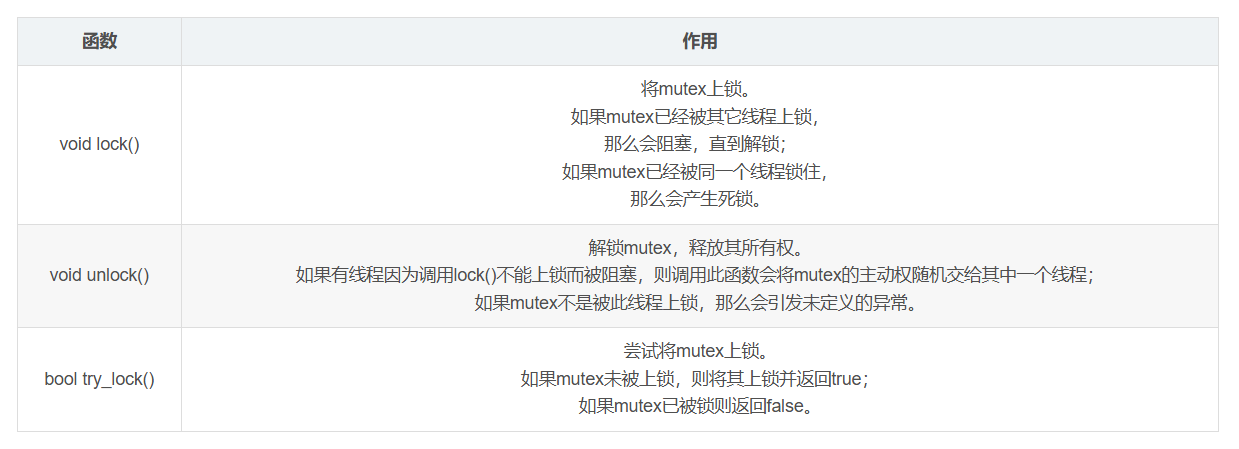在多线程编程中,多个线程协同工作能显著提升程序效率,但当它们需要共享和操作同一资源时,潜在的问题也随之而来;线程间的执行顺序不确定性可能导致资源竞争,可能引发死锁,让程序陷入停滞。
多线程竞争问题示例
我们现在已经知道如何在c++11中创建线程,那么如果多个线程需要操作同一个变量呢?
cpp
#include <iostream>
#include <thread>
using namespace std;
int n = 0;
void count10000() {
for (int i = 1; i <= 10000; i++)
n++;
}
int main() {
thread th[100];
for (thread &x : th)
x = thread(count10000);
for (thread &x : th)
x.join();
cout << n << endl;
return 0;
}可能的两次输出分别是:
plain
991164
996417我们的输出结果应该是1000000,可是为什么实际输出结果比1000000小呢?
在多线程的执行顺序------同时进行、无次序,所以这样就会导致一个问题:多个线程进行时,如果它们同时操作同一个变量,那么肯定会出错。为了应对这种情况,c++11中出现了std::atomic和std::mutex。
std::mutex
std::mutex是 C++11 中最基本的互斥量,一个线程将mutex锁住时,其它的线程就不能操作mutex,直到这个线程将mutex解锁。根据这个特性,我们可以修改一下上一个例子中的代码:
cpp
#include <iostream>
#include <thread>
#include <mutex>
using namespace std;
int n=0;
mutex mtx;
void count10000(){
for(auto i=0;i<10000;i++){
mtx.lock();
n++;
mtx.unlock();
}
}
int main(){
thread th[100];
for (thread &x : th)
x = thread(count10000);
for (thread &x : th)
x.join();
cout<<n<<endl;
return 0;
}mutex的常用成员函数

std::lock_gard
使用mutex需要上锁解锁,但有时由于程序员忘记或者其他奇怪问题时,lock_gard可以自动解锁。其原理大概是构造时自动上锁,析构时自动解锁。示例如下:
cpp
#include <iostream>
#include <thread>
#include <mutex>
using namespace std;
int n=0;
mutex mtx;
void count100000(){
for(auto i=0;i<100000;i++){
lock_guard<mutex> lock1(mtx);
n++;
n--;
}
}
int main(){
thread th[10];
for(int i=0;i<10;i++){
th[i]=thread(count100000);
}
for(int i=0;i<10;i++){
th[i].join();
}
cout<<n<<endl;
return 0;
}std::unique_lock
std::unique_lock是 C++ 标准库中提供的一个互斥量封装类,用于在多线程程序中对互斥量进行加锁和解锁操作。它的主要特点是可以对互斥量进行更加灵活的管理,包括延迟加锁、条件变量、超时等。
cpp
#include <iostream>
#include <thread>
#include <mutex>
#include <chrono>
using namespace std;
int n = 0;
mutex mtx;
void count100000() {
for (auto i = 0; i < 100; ++i) {
unique_lock<mutex> lock1(mtx);
n++;
lock1.unlock(); // 提前解锁,体现unique_lock的灵活性
this_thread::sleep_for(chrono::milliseconds(1)); // 模拟耗时操作
lock1.lock();
n--;
}
}
int main() {
thread th[10];
for (int i = 0; i < 10; ++i) {
th[i] = thread(count100000);
}
for (int i = 0; i < 10; ++i) {
th[i].join(); // 等待所有线程完成
}
cout << n << endl; // 所有线程结束后输出结果(理论上应为0)
return 0;
}公共构造函数
| 函数 | 作用 |
|---|---|
| unique_lock() noexcept = default | 默认构造函数,创建一个未关联任何互斥量的std::unique_lock对象。 |
| explicit unique_lock(mutex_type& m) | 构造函数,使用给定的互斥量m进行初始化,并对该互斥量进行加锁操作。 |
| unique_lock(mutex_type& m, defer_lock_t) noexcept | 构造函数,使用给定的互斥量m进行初始化,但不对该互斥量进行加锁操作。 |
| unique_lock(mutex_type& m, try_to_lock_t) noexcept | 构造函数,使用给定的互斥量m进行初始化,并尝试对该互斥量进行加锁操作。如果加锁失败,则创建的std::unique_lock对象不与任何互斥量关联。 |
| unique_lock(mutex_type& m, adopt_lock_t) noexcept | 构造函数,使用给定的互斥量m进行初始化,并假设该互斥量已经被当前线程成功加锁。 |
| std::unique_lock | 使用非常灵活方便,上述操作的使用方式将在课程视频中作详细介绍。 |
常用成员函数
| 函数 | 作用 |
|---|---|
| lock() | 尝试对互斥量进行加锁操作,如果当前互斥量已经被其他线程持有,则当前线程会被阻塞,直到互斥量被成功加锁。 |
| try_lock() | 尝试对互斥量进行加锁操作,如果当前互斥量已经被其他线程持有,则函数立即返回false,否则返回true。 |
| try_lock_for(const std::chrono::duration<Rep, Period>& rel_time) | 尝试对互斥量进行加锁操作,如果当前互斥量已经被其他线程持有,则当前线程会被阻塞,直到互斥量被成功加锁,或者超过了指定的时间。 |
| try_lock_until(const std::chrono::time_point<Clock, Duration>& abs_time) | 尝试对互斥量进行加锁操作,如果当前互斥量已经被其他线程持有,则当前线程会被阻塞,直到互斥量被成功加锁,或者超过了指定的时间点。 |
| unlock() | 对互斥量进行解锁操作。 |
std::atomic
mutex很好地解决了多线程资源争抢的问题,但它也有缺点:太......慢......了......
比如前面我们定义了100个thread,每个thread要循环10000次,每次循环都要加锁、解锁,这样固然会浪费很多的时间,那么该怎么办呢?接下来就是atomic大展拳脚的时间了。
cpp
#include <iostream>
#include <atomic>
#include <thread>
using namespace std;
atomic<int> n{0};// 列表初始化
void count10000(){
for(int i=0;i<10000;i++)
n++;
}
int main(){
thread th[10];
for(thread& x:th)
x=thread(count10000);
for(auto& x:th)
x.join();
cout<<n<<endl;
return 0;
}可以看到,我们只是改动了n的类型(int->std::atomic_int),其他的地方一点没动,输出却正常了。
atomic,本意为原子,可解释为:
原子操作是最小的且不可并行化的操作。
atomic常用成员函数

死锁问题
在多个线程中由于上锁顺序问题可能导致线程卡死,如下:
cpp
#include <iostream>
#include <thread>
#include <mutex>
using namespace std;
int n=0;
mutex mtx1;
mutex mtx2;
void count100000(){
for(auto i=0;i<100000;i++){
lock_guard<mutex> lock1(mtx1);
lock_guard<mutex> lock2(mtx2);
n++;
n--;
}
}
void count200000(){
for(auto i=0;i<200000;i++){
lock_guard<mutex> lock2(mtx2);
lock_guard<mutex> lock1(mtx1);
n++;
n--;
}
}
int main(){
thread th[10];
for(int i=0;i<10;i++){
if(i%2==0)
th[i]=thread(count100000);
else
th[i]=thread(count200000);
}
for(int i=0;i<10;i++){
th[i].join();
}
cout<<n<<endl;
return 0;
}这是因为在一个线程count100000中mtx1上锁后,另一个线程count200000也正好将mtx2上锁,于是这两个线程没办法获得另一个mutex,这就是死锁问题。
解决方法就是保持一样的上锁顺序,于是当一个线程A抢到第一个mutex时,其他线程无法再获得mutex,即只能线程A按着顺序处理完所有事物。示例如下:
cpp
#include <iostream>
#include <thread>
#include <mutex>
using namespace std;
int n=0;
mutex mtx1;
mutex mtx2;
void count100000(){
for(auto i=0;i<100000;i++){
lock_guard<mutex> lock1(mtx1);
lock_guard<mutex> lock2(mtx2);
n++;
n--;
}
}
void count200000(){
for(auto i=0;i<200000;i++){
lock_guard<mutex> lock1(mtx1);
lock_guard<mutex> lock2(mtx2);
n++;
n--;
}
}
int main(){
thread th[10];
for(int i=0;i<10;i++){
if(i%2==0)
th[i]=thread(count100000);
else
th[i]=thread(count200000);
}
for(int i=0;i<10;i++){
th[i].join();
}
cout<<n<<endl;
return 0;
}